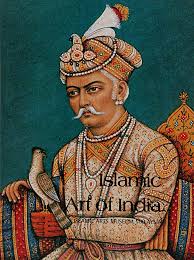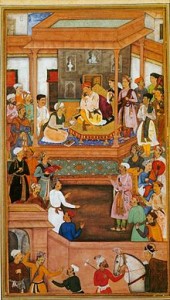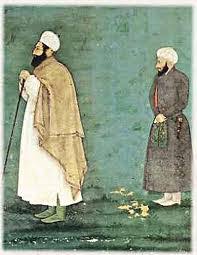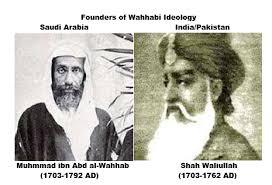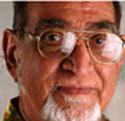I am giving Engineer Asghar Ali’s article on Sirhindi in the end just for information .
Finally it was Sirhindi’s orthodox thoughts which won in the end as every where else in all ages .
‘How this preference for ‘any one but hindus’ accentuated with Sir Syed Ahmad Khan , we will see in next post .
By Asghar Ali Engineer
December 9, 2010
Sheikh Ahmad Sirhindi is a major figure and most controversial too, among Ulema during the Mughal period who left great impact on religious and political ideas of a section of Muslims not only during the Moghul period but also on subsequent periods, particularly during 19th and 20th centuries. He had both followers as well as opponents among Muslims in India. It is, therefore, quite interesting to throw some light on his ideas.
Akbar’s policies led to acceptance of religious pluralism and integration. Akbar happen to come under the influence of Mulla Mubarak’s two sons Abul Fazl and Faizi. Both brothers were persecuted by orthodox Ulema and ultimately found refuge in Akbar’s court. Both belonged to Wahdat al-Wujud school of Sufism. Wahdat al-Wujud (Unity of Being) is the most liberal Sufi school.
Wahdat al-Wujud emphasizes that there is one being and we are all its manifestations. Thus all human beings are one in origin despite different religions, cultures and languages. The second major doctrine of this school is Sulh-I-Kul i.e. total peace and peace with all, a doctrine that eliminates all conflicts and discrimination on all grounds. Akbar was greatly influenced by both the doctrines and he had inquisitive mind which wanted to know basic tenets of all religions.
Thus Akbar was convinced of truth of all religions and played major role in bringing people of different faiths together. India has been a country of great diversities, religious diversity, cultural, racial and linguistic diversities. It never was mono-religious in its history. Any tendency to assert truth of only one religion thus gives rise to conflict and separatism in India. The religions which arose in India – Hinduism, Jainism, and Buddhism besides several tribal practices also accepted diversity of views. The famous doctrine that ‘truth is one but it is manifested in different ways’ was also product of this diversity.
Akbar’s greatness lay in the fact that he understood and accepted this Indian reality although he himself belonged to Islamic faith. As a just ruler he should have been neutral but Akbar was not only neutral but also accepted truth of other religions. He never considered people of other religions as Kafirs as many orthodox theologians would do. Qur’an also never called people of other religions ‘Kafirs’. On the contrary it asserted that a true Muslim is one who shows equal respect for all prophets and also said that ‘We have sent guides to all the nations’.
Thus every nation (or tribe or country or Qaum) has been blessed with a guide from Allah and thus have been given truth from Allah. Qur’an addresses only those Arabs of Mecca as Kafirs who denied truth preached by Muhammad (PBUH) although they had no truth of their own or any revealed scripture. And Qur’an preached doctrine of co-existence even with those Kafirs who did not persecute Muhammad and his followers. It propounded doctrine of ‘for you is your religion and for me is mine’.
However, for various reasons this liberal and open approach of the Qur’an and Prophet (PBUH) did not always find acceptance with some narrow minded Muslims and they denounced not only non-Muslims but also those Muslims as Kafirs who did not agree with them on theological matters. These theological differences are so sharp until today that every sect of Islam considers the other sect as having gone astray and ‘Kafir’
The Sufis, especially those belonging to Wahdat al-Wujud School, did not agree with such exclusionary approach and always recognizing truth of other religions. Akbar was also subscribed to this approach under the influence of Faizi Brothers. But he went a step further and floated his own creed which he called Deen-i-Ilahi. I think it is not for a ruler to start his own creed. It will always be seen in the perspective of political interest and not a matter of heart and soul or something spiritual.
It was not for nothing that all prophets in the Qur’an (with two exceptions) were from amongst poor shepherds or from amongst ordinary people having no such interest. A founder of religion cannot be seen as one having some political interest. It is not then surprising that even those closest to him did not accept his Akbar’s Deen-i-Ilahi and it soon died down. It did not survive after Akbar’s death.
However, this does not detract from Akbar’s greatness and his attempt to integrate people of India and adopt an exclusionary approach. But, as pointed out earlier, those with narrow theological approach to religion did not like Akbar’s policies and wanted to assert superiority of Islam, especially as it belonged to the ruling class. It must be pointed out here that religion should be treated primarily as spiritual approach creating humility and spirit of truth and should not be allowed to become an instrument of power.
The theologians, however, take religion as a source of power and matter of sole truth which creates attitude of arrogance. Sheikh Sirhindi and his followers belonged to this school of thought. They believed their version of Islam was the source of sole truth and all those who differed from them had gone astray. Sheikh Sirhindi considered it as his mission to revive true Islam. As he was borne on the eve of second millennium of Islamic calendar, he was referred to as Mujaddid alf-i-Sani i.e. renewer of second millennium.
Thus Khalid Umri from the school of Ahl-i-Hadith says that the Ulema lost their influence in Akbar’s court and this encouraged the Hindus to assert themselves and this prepared the way for founding the creed of Deen-i-Ilahi. Mulla Mubarak and his sons Abul Fazl and Faizi inculcated ‘anti-Islamic’ attitude in Akbar in order to serve their own interests and to seek closeness to Akbar. Abul Fazl and Faizi made Akbar hostile to Ulema and to take revenge [1].
The orthodox Ulema saw these developments in Akbar’s court as corruption (Fasaad) and condemned it. Khalid Umri considers Deen-i-Ilahi as harmful and writes that this Deen-i-Ilahi brought harmful changes in Akbar’s court and then whole country was affected by it and the Ulema prepared themselves to confront this situation and the way they tried to revive religion and then he quotes Qazi Aslam Saif:
Prostration for respect (Isajda-i-Ta’zeem) before Akbar was made obligatory. Names like Muhammad and Ahmad were banned. Circumcision was not allowed. Cow slaughter was banned and pork was permitted so much so that breeding of dogs and swines were considered part of culture. The Shari’ah rules were ridiculed. Shi’ah beliefs and innovations were permitted. Temples were patronized and respected and mosques were locked. The Ulema and Mashaikh (elderly divine persons) were persecuted and harassed. The Sufis were treated with contempt and a campaign was launched to create contempt against them.
The dangers of Akbar’s Deen-i-Ilahi were felt throughout Islamic world and some servants of Allah showed courage and declared their opposition to Deen-i-Ilahi. They worked for renewal of faith and tried to promote Tawhid and Sunnah with firmness and courage.
One can see in these lines the highly exaggerated opposition to Akbar’s liberal and integrative policies. The account given by Qazi Aslam Saif is far from true. No ruler can afford to lock the mosques and allow pork while banning cow slaughter. Or ban the names like Muhammad and Ahmad. This only shows the depth of opposition to liberalism and inclusive and integrative policies.
It was in such atmosphere created by the Ulema against Akbar that Sheikh Sirhindi launched his campaign against Akbar, on one hand, and, Sufis like Abul Fazl and Faizi, on the other. The Sheikh’ and his followers wanted to revive strict application of orthodoxy and this is what they mean when they refer to Kitab wa Sunnah (i.e. the Qur’an and the Prophet’s sayings and doings – Sunnah). They forget that there have been different interpretations of Holy Book and also there is no unanimity about Hadith.
What Sirhindi was opposed to was liberal approach to religion and hence he firmly opposed the doctrine of Wahdat al-Wujud (unity of being) which opens the doors to all religions and makes them acceptable and respectable. He came out with his own doctrine of Wahdat as-Shuhud i.e. unity of witnessing or appearance. Wahdat as-Shuhud strengthened orthodoxy.
Though Emperor Jahangir did not advocate Akbar’s Deen-i-Ilahi, he did adopt liberal approach. But unlike Akbar, Jahangir had not much love lost for Sufism or for religion as such. But he too, continued with the practice of Sajda-e-Ta’zeem. He once summoned Sheikh Sirhindi and expected him to perform the Sajda’. However, the Sheikh refused and greeted the emperor with Islamic way i.e. As Salam-o-Alaikum (peace be upon you).
This offended Jahangir and he imprisoned the Sheikh in Gwalior fort where he spent more than two and half years However, the Sheikh had following among a powerful group of courtiers who pressurized Jehangir to release him and he was released honourably. Sheikh Ahmad had created spheres of influence among courtiers and their followers. The Kitab and Sunnah discourse had their own attraction and many people thought, as it often happens today too, their problem is because they do not follow Qur’an and Hadith.
Since Sheikh Ahmad was opposed to the doctrine of Wahdat al-Wujud, it resulted in separatist politics too. The ruler, according to him should rule as per Qur’an and Sunnah ignoring Indian realities. It was negation of Akbar’s inclusive policy. Rule according to Qur’an and Sunnah could be valid in Muslim majority countries but not in countries like India where Muslims were a small minority.
Jahangir and Shahjahan too understood Indian reality which was much more complex and more or less followed the policy of integration than separation. But things changed with Aurangzeb. Aurangzeb was a very shrewd ruler. He wanted to seize power from Dara Shikoh whom Shahjahan had appointed his heir apparent. Dara Shikoh, like Akbar, was under the influence of Sufi Islam. He had studies Hindu scriptures in Sanskrit and also translated Upanishads in Persian under the title of Sirr-e-Akbar (The Great Mystery). He also wrote a book Majma’ ul Bahrayn (Co-mingling of Two Oceans- Islam and Hinduism). He compares teachings of two religions and finds great deal of similarities.
Thus Dara Shikoh had gone a step further than Akbar and had he come to power he would have followed policies to bring people of India together irrespective of different religions. Aurangzeb was disciple of son of Sheikh Sirhindi and had imbibed Sheikh’s outlook through his son. Also, Sirhindi, as pointed out before, had influence over several courtiers and wanted to get their support for seizing power from Dara Shikoh and following Sirhindi’s policies suited him politically too.
However, Aurangzeb was politically very shrewd and he won over some important Rajput Sardars like Mirza Raja Jaisingh and ruler of Jodhpur on his side and made Mirza Raja Jaisingh his army chief. Thus on one hand he encouraged Islamic orthodoxy to win over the Ulema and those nobles who were under the influence of Sheikh Sirhindi, and influential Rajput Sardars, on the other. But on the whole Aurangzeb’s rule resulted in separatism rather than integration. Later on he also re-imposed Jizyah on non-Muslims which alienated many Hindus.
None of Aurangzeb’s sons proved to be strong enough to ensure stability of the empire and Marathas who had challenged Aurangzeb’s rule under the leadership of Shivaji, began to attack Delhi and indulged in plunder and loot. Jats and Rohillas too attacked Delhi and resulted in anarchy. This prompted Shah Waliyullah to invite Ahmadshah Abdali to come and teach Marathas a lesson.
Shah Waliyullah, it is important to note, was man of vision. He tried to bring about reconciliation between the doctrines of Wahdat-ul-Wujud and Wahdat al-Shuhud to unite Muslims following two different schools of thought. However, despite Shah Sahib’s sincerity, it did not work Also. Inviting Abadali was not a politically wise decision. Whatever Shah Sahib’s intention – to weaken Maratha power, it did not work out that way as world of political power struggle has its own dynamics and Abadali was, after all, a foreign invader. He came, looted and plundered and killed and went away.
Shah Waliyullah was a great thinker and observer of socio-political scene but could do little to change the balance of political power. He was not like other theological thinkers who confine themselves to theology but a keen observer of social scene and an analyst. He could analyze the causes off decline of Moghul Empire but it was not in his power to reverse the trend.
His followers were divided into two groups those who accepted composite nationalism and prominent in this group was Deoband School and Jami’at al-Ulema-i-Hind. Jami’at, in fact opposed separatist politics and challenged two nation theory and stood behind Gandhiji’s leadership. Maulana Qasim Ahmad Nanotvi had issued a fatwa urging Muslims to join Indian National Congress and collected similar Fatwas from other Ulema and published under the title Nusrat al-Ahrar. Thus right from the beginning these Deobandi Ulema stood with composite nationalism.
As opposed to this group of Muslims there were those who came under direct or indirect influence of Sheikh Sirhindi and adopted separatist politics. Among them there were both theologians as well as intellectuals. However, here some qualifications are necessary. All those who rejected composite nationalism and opted for separate nationalism were not necessarily influenced by Sheikh Sirhindi. Jinnah, for example, had his own reasons to opt for separatism. He in fact shifted his position from composite to separate nationalism. It was more for personal than ideological reasons. He probably might not have even heard of Sheikh Ahmad Sirhindi.
But among theologians and secular intellectuals there were those who came directly or indirectly under the influence of Sheikh Sirhindi and became separatists and rejected composite nationalism. Also, there were those who admired Sirhindi but did not necessarily agree with separatist politics. Iqbal was among them. Iqbal was undoubtedly admirer of Sirhindi but his political position was much more complex.
He was and was not separatist in politics. He neither adopted clear separatist stand nor denounced it. Iqbal had great attraction for power. He wanted to see Muslims of Indian sub-continent empowered. Also, ideologically Iqbal was internationalist and rejected nationalism as narrow and unacceptable. He considered Muslims an international community both politically and spiritually. He said in one of his poems that nationalism is the shroud of Millat (i.e. international Muslim community).
Maulana Husain Ahmad Madani, on the other hand, considered Muslims a Millat only in spiritual sense but accepted composite nationalism in political sense. He separated spiritual from political. Muslims of Indian sub-continent greatly admire Iqbal’s poetry as he wants to see Muslims of subcontinent duly empowered and criticizes mullahs for whom Islam is only saying Namaz in mosques, nothing more.
It is interesting to note that there is qualitative difference between Jinnah’s separatism and Iqbal’s seeing Muslims politically empowered. Jinnah was hardly ideologically committed to Islam or even interested in Islam. His was purely political fight and partition came about on certain political questions, constitutional arrangements and sharing power.
For Iqbal it was not merely a secular question of constitutional arrangement or share in political power. More than anything else it was question of Islamic vision. According to Iqbal Muslims will not accept Nehruvian atheistic socialism but would like to have an autonomous region to experiment with Islamic socialism. Thus Iqbal’s was a unique and complex position. He was against narrow secular nationalism and critiques western concept of nationalism in his poetry.
He was also not, at the same time, a separatist like Maulana Maududi who rejected any concept of secular politics and modelled his concept of Islamic state on communist model, one party system with caliph, the ruler having all the powers. The Islamic party Maududi calls as Hizbullah i.e. party of Allah. He advised his followers in India too not to participate in secular politics.
Iqbal, on the other hand, was much more open and does not devise any closed political system although he talks of experimenting with Islamic socialism. Maulana Maududi’s system is too conservative whereas Iqbal’s is quite revolutionary. Iqbal is much more open to other faiths and his vision is much broader and modern. Iqbal is a category by himself. He is neither a separatist nor a nationalist.
Thus it would be seen that there are different categories of separatism among Muslim political system builders. There is no single system available. In most of the Muslim majority countries one finds authoritarian regime, more feudal than based on modern political or Islamic theories. In fact throughout history it was personal authoritarian rule rather than based on any Islamic theory and the same continues until today.
There is no Islamic political system in any Muslim country including Pakistan. Partition itself was on secular lines and it was Zia-ul-Haq who declared Pakistan as ‘an Islamic state’ though he himself was not clear what it meant except that he enforced Hudud laws. His rule itself never derived legitimacy from any Islamic source. He was, at best, a military dictator.
Also, in the globalized world, separatism is losing its political significance. Large number of Muslims is migrating to other non-Muslim countries and today a significant number of Muslims live as minority and Islamic separatism has no meaning for them. It is composite nationalism which would serve their purpose. Thus those who opposed separatism in Indian sub-continent were more relevant and realistic. Sheikh Ahmad Sirhindi has very narrow circle of followers.
Sheikh Ahmad’s theology poses another major problem. Even if Islamic polity is to be based on Qur’an and Sunnah, which interpretation would be acceptable?
—-
Asghar Ali Engineer was an Indian reformist-writer and social activist. Internationally known for his work on liberation theology in Islam, he led the Progressive Dawoodi Bohra movement. He was the founder and Chairperson of the Centre for Study of Society and Secularism.


